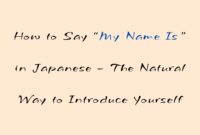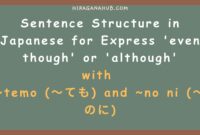Understanding Japanese Verb Groups and Their Negative Conjugation
Hello everyone! This time, we’re diving deeper into Japanese verbs, or
どうし (動詞). Japanese verbs are divided into three main
groups: Group 1, Group 2, and Group 3. Each group has its own
method for negative conjugation. Let’s start with Group 1!

Group 1: ごだん どうし (U-verbs)
Group 1 verbs, or U-verbs, typically end with the hiragana
characters:
う (u), る (ru), つ (tsu), む (mu), ぬ (nu), ぶ (bu), く (ku), ぐ (gu),
and す (su).
Here are a few examples:
- うたう (utau) : to sing
- まつ (matsu) : to wait
- はしる (hashiru) : to run
- わらう (warau) : to laugh
- まなぶ (manabu) : to study
- さがす (sagasu) : to search
- つくる (tsukuru) : to create
- およぐ (oyogu) : to swim
- はたらく (hataraku) : to work
To conjugate Group 1 verbs into their
negative form, change the vowel sound of
う (u) → あ (a) and add ない (nai) at the
end.
For example:
- うたう (utau) → うたわない (utawanai) : not singing
- まつ (matsu) → またない (matanai) : not waiting
- はしる (hashiru) → はしらない (hashiranai) : not running
- わらう (warau) → わらわない (warawanai) : not laughing
- まなぶ (manabu) → まなばない (manabanai) : not studying
- さがす (sagasu) → さがさない (sagasanai) : not searching
Important note: The verb ある (aru),
meaning “to be” (for inanimate objects), has the negative form
ない (nai), not あらない (aranai).
Group 2: いちだん どうし (Ru-verbs)
Group 2, or Ru-verbs, usually end with
いる or える.
Here are a few examples:
- ねる (neru) : to sleep
- しんじる (shinjiru) : to believe
- あける (akeru) : to open
- おしえる (oshieru) : to teach
- きえる (kieru) : to disappear
- えらぶ (erabu) : to choose
To convert these verbs into the negative form,
drop the る (ru) and add ない (nai):
- ねる (neru) → ねない (nenai) : not sleeping
-
しんじる (shinjiru) → しんじない (shinjianai) : not
believing - あける (akeru) → あけない (akenai) : not opening
- おしえる (oshieru) → おしえない (oshienai) : not teaching
- きえる (kieru) → きえない (kienai) : not disappearing
- えらぶ (erabu) → えらばない (erabanai) : not choosing
However, there are exceptions. Some verbs that end with
いる or える are
Group 1 verbs, like いく (iku), which
means “to go.” Its negative form follows the rules of Group
1:
- いく (iku) → いかない (ikanai)
You’ll need to memorize which verbs belong to Group 1 and
which are Group 2.
Group 3: ふきそく どうし (Irregular Verbs)
Group 3 consists of only
two irregular verbs:
- する (suru) : to do
- くる (kuru) : to come
These two verbs
don’t follow the regular conjugation patterns, so you need
to memorize them.
Negative forms:
- する (suru) → しない (shinai) : not doing
- くる (kuru) → こない (konai) : not coming
Additionally, suru can turn nouns into verbs.
For example:
-
べんきょうする (benkyou suru) : to study →
べんきょうしない (benkyou shinai) : not studying -
うんてんする (unten suru) : to drive →
うんてんしない (unten shinai) : not driving
Negative Conjugation Summary
| Group | Positive | Negative |
|---|---|---|
| 1 | うたう (utau) | うたわない (utawanai) |
| まつ (matsu) | またない (matanai) | |
| 2 | ねる (neru) | ねない (nenai) |
| しんじる (shinjiru) | しんじない (shinjianai) | |
| 3 | する (suru) | しない (shinai) |
| くる (kuru) | こない (konai) |
Exceptions and Tips for Memorization
Some いる or える verbs belong to
Group 1. Here are a few you need to be aware of:
- うたう (utau) : to sing
- あるく (aruku) : to walk
- さがす (sagasu) : to search
- いく (iku) : to go
It’s essential to memorize these exceptions, as they don’t
follow the typical conjugation rules of Group 2.
Japanese verb groups and their
negative conjugations is essential for understanding the
language. Repetition is key to cementing these patterns in
your mind, so don’t be discouraged if it takes a few tries!
Once you’re comfortable with this, learning more complex grammar will be
much easier.
This article helps you understand the
basics of Japanese verb conjugation. If you have any
questions or want to share more examples,
please to leave a comment. See you in the next post, and
happy studying!


